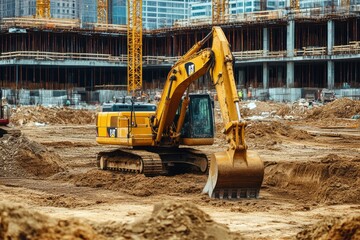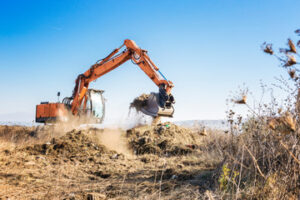An excavation contractor specializes in earthmoving, site preparation, and excavation tasks. They dig foundations, trenches, and grading to prepare sites for construction projects.
Excavating Contractor clearly communicates project timelines and costs to clients. They will also be licensed, insured, and able to provide references and reviews from past clients.
Foundation excavation involves removing soil to create space for the base of structures like residential homes or commercial buildings. It is a crucial step in construction that ensures the stability and longevity of buildings and reduces future structural issues. Professional excavation contractors are experienced in digging foundations and have the skills and equipment to complete this task efficiently and safely.
When choosing an excavating contractor for your project, make sure to ask about their safety commitments and work procedures. They should also provide detailed estimates for all services. This will help you determine if their rates are competitive and fair. Additionally, you should consider their equipment and technology to ensure that they are up-to-date and well-maintained. This will ensure that your project is completed on time and within budget.
Before the actual excavation begins, contractors will survey the site and determine the best way to dig a foundation. They will take into consideration factors like soil type, groundwater levels, and topography. They will also conduct soil tests to assess the foundation’s load-bearing capacity and determine the optimal depth for the building’s base.
After the foundation is in place, construction work can begin on the rest of the structure. This includes installing utilities like water, sewage, and electrical lines. In addition, contractors will grade the site to ensure proper drainage and prevent water damage to the foundation.
The right excavating contractor will have extensive experience in excavation and can handle all aspects of the project, from start to finish. They will be able to manage complex projects with ease and provide cost-efficiency. They will also ensure that your foundation excavation is performed safely and in accordance with all local, state, and federal regulations. They will also protect surrounding vegetation and wildlife with erosion control measures and minimize waste. In addition, they will dispose of all excavated materials responsibly, ensuring that the environment is not affected. This is a crucial aspect of the construction process and should be carefully considered by all potential contractors.
Land Clearing
Land clearing and site preparation are critical steps in construction projects that lay the foundation for future building phases, mitigating risks, enhancing efficiency, and optimizing project timelines. Professional contractors can leverage decades of experience and specialized equipment to ensure that land clearing is done accurately and safely, allowing the construction process to move forward without a hitch.
The land clearing process typically involves removing trees, bushes, and other vegetation from the property. This can be accomplished through manual labor or heavy machinery like bulldozers and excavators. While many people attempt DIY land clearing to save money, it’s important to seek the expertise of professionals who have the right equipment and know how to handle it safely. This helps prevent injury to workers and reduce the risk of damage to property or natural resources.
Choosing environmentally friendly land clearing methods is also essential to the success of a construction project. Experts use techniques that prioritize sustainability and help preserve the ecosystem, including reducing disturbance to natural habitats and preventing erosion and sedimentation in nearby waterways. In addition, they are aware of regulations regarding protected species and wetlands and adhere to these standards, ensuring that the construction project complies with all local laws and requirements.
Maintaining effective debris management is another crucial aspect of land clearing. Professionals employ a variety of strategies to reduce waste and minimize environmental impacts, such as burning, mulching on-site, or transporting the debris for proper disposal. In addition, they take care to implement erosion control measures that protect the soil and the environment, preserving the integrity of the site for a more productive future.
In addition, land-clearing specialists can offer tips and tricks that can make the process of clearing more efficient. For example, they can recommend that the site be surveyed ahead of time to understand the terrain, identify types of vegetation, and note any obstacles. They can then choose the best clearing method and equipment, resulting in a smoother, more cost-effective process. They can also advise on scheduling the clearing process during off-season to avoid price hikes and other unforeseen complications.
Excavation
Construction projects of all sizes and types rely on excavation for their foundations, utilities, and site development. Without proper planning and execution, these critical processes could lead to structural instability and other problems down the line. Professional excavation contractors offer the skills, expertise, and equipment to ensure that these phases are handled correctly and efficiently.
Whether you’re building a new residential home, commercial structure, or industrial complex, excavation is an integral part of the process. It helps to reshape the landscape and clear away any debris, rocks, or roots that may interfere with your project. It also allows for grading, which can address drainage issues that could weaken your foundation over time.
Before the excavation process can begin, engineers and contractors must assess the site. This involves soil testing, surveying, and marking utility lines so that they don’t get damaged during excavation. It’s important to choose an excavation contractor with a proven track record and experienced professionals. They should also be licensed and insured to protect themselves against potential liabilities. Look for a company that uses modern equipment and technology to improve efficiency and accuracy, as well as one that prioritizes safety standards and environmental responsibility.
Excavation differs from digging, in that it is typically done for construction and engineering purposes whereas digging is usually for personal or gardening purposes. It is also deeper and typically requires heavy machinery like bulldozers, backhoes, or excavators whereas digging can be done with smaller equipment such as shovels or spades.
There are various stages in the excavation process, including rough staking, site preparation, and trenching. Rough staking showcases the designated areas where permanent structures will exist, while site preparation prepares the area for excavation by clearing any obstacles and addressing grading issues. Once the site is ready for digging, excavation begins by using excavators or backhoes to dig trenches to the desired depth. Loose soil is then dressed, which consists of adding or removing material to improve the quality and density of the soil.
The next phase in the excavation process is backfilling, which entails filling trenches with clean dirt to prevent water from seeping into the foundation and damaging it over time. Finally, the final stage in excavation is paving, which includes using asphalt, concrete, or gravel to create paved surfaces and roads.
Paving
A key part of any construction project is the paving process. Whether it’s for a road, driveway, or parking lot, the laying of a new surface can greatly enhance the value and usefulness of commercial or residential property. The excavating contractor plays a vital role in this process by clearing the ground of any existing debris, grading the land to ensure proper drainage, and making sure that a strong foundation is laid before beginning the actual paving.
Paving can be done in a variety of ways, depending on the specific needs of each project. The most common form is asphalt paving, which involves the use of materials that are pliable enough to withstand the weight and movement of vehicles. Another popular option is concrete paving, which uses a much more rigid material and is typically used in industrial settings or airport runways. In either case, the paving must be properly designed and executed in order to be able to withstand the demands of regular traffic and environmental conditions.
An excavation contractor who specializes in paving will understand the unique requirements of each project and be able to develop a plan that will maximize its effectiveness. For example, a developer may need to install a drainage system in order to prevent flooding or structural damage. This requires the excavation contractor to dig trenches that will effectively direct water flow away from the structure.
In addition to ensuring the structure has a strong base, a well-executed excavation and grading process will also help to extend its lifespan by reducing the risk of water damage. If water is allowed to accumulate, it can cause the base and subgrade layers of the pavement to deteriorate over time.
A skilled excavating contractor will know how to prepare the site in a way that minimizes the risk of such damage, thereby extending the life of the paved surface. In order to do this, the contractor will carefully plan for each stage of construction, including excavation, grading, and paving. This will make sure that the entire project runs as smoothly as possible and minimizes the need for costly repairs and redesigns in the future.


